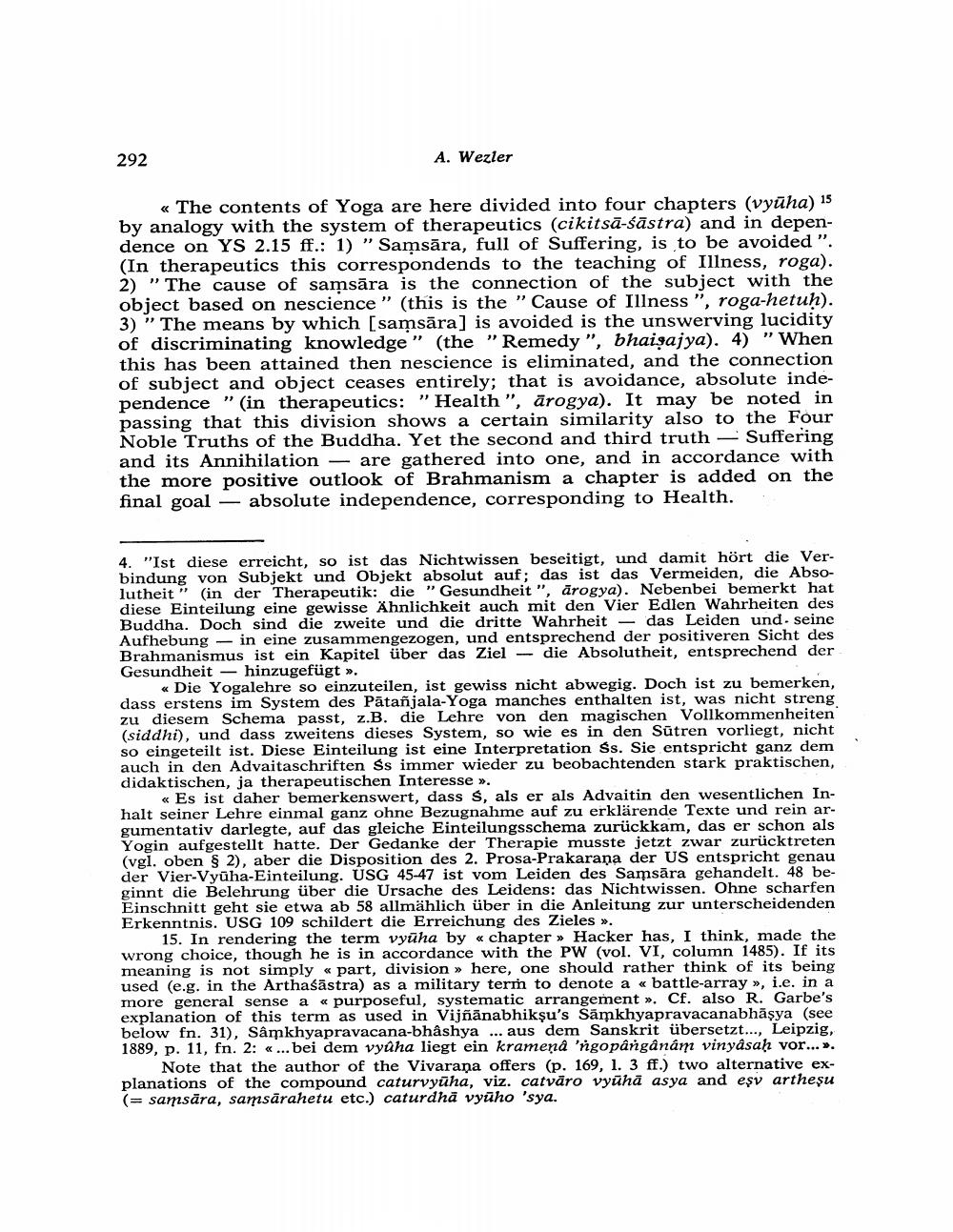________________
292
A. Wezler
« The contents of Yoga are here divided into four chapters (vyūha) 15 by analogy with the system of therapeutics (cikitsā-śāstra) and in dependence on YS 2.15 ff.: 1) "Samsāra, full of Suffering, is to be avoided ". (In therapeutics this correspondends to the teaching of Illness, roga). 2) "The cause of samsāra is the connection of the subject with the object based on nescience” (this is the "Cause of Illness", roga-hetuh). 3) "The means by which [samsāra] is avoided is the unswerving lucidity of discriminating knowledge " (the "Remedy", bhaişajya). 4) ” When this has been attained then nescience is eliminated, and the connection of subject and object ceases entirely; that is avoidance, absolute independence" (in therapeutics: "Health", ārogya). It may be noted in passing that this division shows a certain similarity also to the Four Noble Truths of the Buddha. Yet the second and third truth — Suffering and its Annihilation — are gathered into one, and in accordance with the more positive outlook of Brahmanism a chapter is added on the final goal — absolute independence, corresponding to Health.
4. "Ist diese erreicht, so ist das Nichtwissen beseitigt, und damit hört die Verbindung von Subjekt und Objekt absolut auf; das ist das Vermeiden, die Absolutheit" (in der Therapeutik: die "Gesundheit", arogya). Nebenbei bemerkt hat diese Einteilung eine gewisse Ähnlichkeit auch mit den Vier Edlen Wahrheiten des Buddha. Doch sind die zweite und die dritte Wahrheit – das Leiden und seine Aufhebung - in eine zusammengezogen, und entsprechend der positiveren Sicht des Brahmanismus ist ein Kapitel über das Ziel - die Absolutheit, entsprechend der Gesundheit - hinzugefügt ».
«Die Yogalehre so einzuteilen, ist gewiss nicht abwegig. Doch ist zu bemerken, dass erstens im System des Pātañjala-Yoga manches enthalten ist, was nicht streng zu diesem Schema passt, z.B. die Lehre von den magischen Vollkommenheiten (siddhi), und dass zweitens dieses System, so wie es in den Sütren vorliegt, nicht so eingeteilt ist. Diese Einteilung ist eine Interpretation Śs. Sie entspricht ganz dem auch in den Advaitaschriften Ss immer wieder zu beobachtenden stark praktischen, didaktischen, ja therapeutischen Interesse ».
«Es ist daher bemerkenswert, dass s, als er als Advaitin den wesentlichen Inhalt seiner Lehre einmal ganz ohne Bezugnahme auf zu erklärende Texte und rein argumentativ darlegte, auf das gleiche Einteilungsschema zurückkam, das er schon als Yogin aufgestellt hatte. Der Gedanke der Therapie musste jetzt zwar zurücktreten (vgl. oben § 2), aber die Disposition des 2. Prosa-Prakarana der US entspricht genau der Vier-Vyüha-Einteilung. USG 45-47 ist vom Leiden des Samsāra gehandelt. 48 beginnt die Belehrung über die Ursache des Leidens: das Nichtwissen. Ohne scharfen Einschnitt geht sie etwa ab 58 allmählich über in die Anleitung zur unterscheidenden Erkenntnis. USG 109 schildert die Erreichung des Zieles ».
15. In rendering the term vyūha by « chapter » Hacker has, I think, made the wrong choice, though he is in accordance with the PW (vol. VI, column 1485). If its meaning is not simply « part, division >> here, one should rather think of its being used (e.g. in the Arthaśāstra) as a military term to denote a « battle-array », i.e. in a more general sense a «purposeful, systematic arrangement ». Cf. also R. Garbe's explanation of this term as used in Vijñānabhikṣu's Samkhyapravacanabhāşya (see below fn. 31), Sâmkhyapravacana-bhâshya ... aus dem Sanskrit übersetzt..., Leipzig, 1889, p. 11, fn. 2: «... bei dem vyûha liegt ein kramena 'ngopârgânám vinyasah vor...».
Note that the author of the Vivarana offers (p. 169, 1. 3 ff.) two alternative explanations of the compound caturvyűha, viz. catvāro vyūhā asya and eşv artheşu (= sansära, samsārahetu etc.) caturdha vyūho 'sya.




